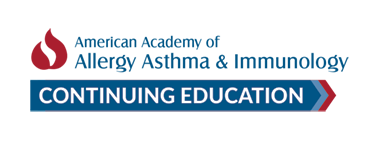
2017 NESA Spring Allied Health Practitioner Update
Credit claiming is open for this activity, and will remain open through 31 December 2017.
Requests to claim credit on or after 1 January 2018 will be subject to an administrative fee.
This live meeting will take place on 7 April 2017.
The Spring Allied Health Update is designed for Allied Health providers who care for people with allergic disease and/or asthma.
Registration Information
| Registration Type | Fee |
|---|---|
| Full Day Meeting (Includes lunch) | $185.00 |
| Half Day Meeting (Lunch not included) | $125.00 |
Please scroll down to the bottom of the page to select your registration type, click 'Add to cart,' and complete payment.
Click here for detailed registration instructions: ![]() NESA Spring Meetings Registration Instructions.pdf
NESA Spring Meetings Registration Instructions.pdf
Credit must be claimed by 31 December 2017. Credit requests on or after 1 January 2018 will be subject to an administrative fee.
Target Audience
- Nurses
- Medical Assistants
- Nurse Practitioners
- Allergist/Immunologists
- Primary Care Physicians
Learning Objectives
Upon completion of this activity participants should be able to:
- Describe symptoms and evaluate patients with possible mast cell disorders
- Describe the immunopathologic basis for celiac disease
- Recognize the presenting symptoms of non-celiac gluten sensitivity
- Identify and discuss management of hypersensitivity reactions to various chemotherapy agents
- Describe the challenges posed by severe asthma
- Distinguish between patients who require novel therapies and those who do not
- Recognize indications for use of currently approved biologic therapies in asthma
- Describe the indications for replacement immunoglobulin
- Describe the advantages and disadvantages of subcutaneous immunoglobulin treatment
- Define telephone triage and how it is used
- Identify processes and documents and develop algorithms or protocols that promote a successful telephone triage program
- Develop a list of facilitators of communication used during the telephone triage process
- Define spirometry and why it is used, and discuss the key measures of test results
- Develop skills in instructing patients on how to perform a high quality spirometry test
- Identify and overcome patient-related problems and errors that might be encountered during patient performance of spirometry
- Recognize the signs and symptoms of anaphylaxis and develop a step-wise protocol for its treatment
- Identify ways to communicate with and train office staff for the incidence of anaphylaxis
- Demonstrate proper inhaler technique using a metered-dose inhaler, with and without a holding chamber
- Describe the proper use and cleaning of a debulizer and compressor, including describing the difference between reusable and non-reusable nebulizer cups
- Demonstrate the proper use of dry-powder inhalers
Available Credit
- 8.00 AttendanceAttendance credit.
- 8.00 CECE credit.
- 8.00 CMECME credit.

 Facebook
Facebook X
X LinkedIn
LinkedIn Forward
Forward